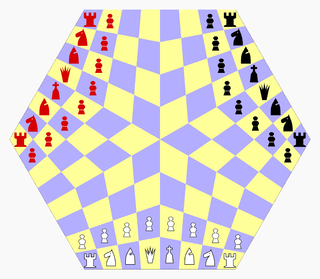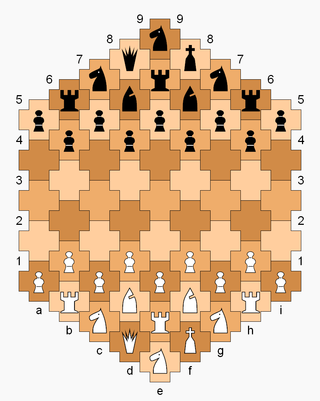Grant Acedrex is a medieval chess variant dating back to the time of King Alfonso X of Castile. It appears in the Libro de los Juegos of 1283.
Grant Acedrex is a medieval chess variant dating back to the time of King Alfonso X of Castile. It appears in the Libro de los Juegos of 1283.
The following rules are from the reconstruction given on the website of Jean-Louis Cazaux, based on work by him and Sonja Musser. The game is played on a 12×12 board.
The king moves as like modern king. Its Betza notation is thus K. Castling does not exist in Grant Acedrex. However, on its first move, a king may make a diagonal or orthogonal leap of two squares (Betza notation AD) in addition to its normal moves.
The aanca (a beautiful and fearsome bird, very similar to a roc, sometimes translated incorrectly as gryphon) moves one square diagonally (like a ferz), before optionally continuing orthogonally outward any number of squares. Its Betza notation is t[FR].
The unicornio (the illustration on the medieval codex shows a rhinoceros's head) moves like a modern knight, before continuing diagonally outward any number of squares. (In H. J. R. Murray's translation, its first move is a non-capturing knight move, after which it acts as a bishop for the rest of the game.) Its Betza notation is t[NB].
In Grant Acedrex, a player wins by either checkmating or stalemating the opponent. A player can also win by capturing all the opponent's pieces leaving them with a bare king.
The game could be sped up by using eight-sided dice to dictate which piece could move that turn, ranking them in the order: king (8), aanca (7), unicornio (6), rook (5), lion (4), crocodile (3), giraffe (2), and pawn (1). [1]
The multi-variant Chess engines Fairy-Max and Postduif can play Grant Acedrex under the XBoard or WinBoard user interface. [2] [3] [4]

Chaturanga is an ancient Indian strategy board game. While there is some uncertainty, the prevailing view among chess historians is that it is the common ancestor of the board games chess, xiangqi (Chinese), janggi (Korean), shogi (Japanese), sittuyin (Burmese), makruk (Thai), ouk chatrang (Cambodian) and modern Indian chess.
A fairy chess piece, variant chess piece, unorthodox chess piece, or heterodox chess piece is a chess piece not used in conventional chess but incorporated into certain chess variants and some chess problems. Compared to conventional pieces, fairy pieces vary mostly in the way they move, but they may also follow special rules for capturing, promotions, etc. Because of the distributed and uncoordinated nature of unorthodox chess development, the same piece can have different names, and different pieces can have the same name in various contexts. Most are symbolised as inverted or rotated icons of the standard pieces in diagrams, and the meanings of these "wildcards" must be defined in each context separately. Pieces invented for use in chess variants rather than problems sometimes instead have special icons designed for them, but with some exceptions, many of these are not used beyond the individual games for which they were invented.
Tamerlane chess is a medieval chess variant. Like modern chess, it is derived from shatranj. It was developed in Central Asia during the reign of Emperor Timur, and its invention is also attributed to him. Because Tamerlane chess is a larger variant of chaturanga, it is also called Shatranj Al-Kabir, as opposed to Shatranj as-saghir. Although the game is similar to modern chess, it is distinctive in that there are varieties of pawn, each of which promotes in its own way.

Hexagonal chess is a group of chess variants played on boards composed of hexagon cells. The best known is Gliński's variant, played on a symmetric 91-cell hexagonal board.
Legan chess is a chess variant invented by L. Legan in 1913. It differs from standard chess by the starting position as well as by pawn movements.
Chess with different armies is a chess variant invented by Ralph Betza in 1979. Two sides use different sets of fairy pieces. There are several armies of equal strength to choose from, including the standard FIDE army. In all armies, kings and pawns are the same as in FIDE chess, but the four other pieces are different.

Senterej, also known as Ethiopian chess, is a regional chess variant, the form of chess traditionally played in Ethiopia and Eritrea. It was the last popular survival of shatranj. According to Richard Pankhurst, the game became extinct sometime after the Italian invasion of Ethiopia in the 1930s. A distinctive feature of Senterej is the opening phase – players make as many moves as they like without regard for how many moves the opponent has made; this continues until the first capture is made. Memorization of opening lines is therefore not a feature of the game.
Omega Chess is a commercial chess variant designed and released in 1992 by Daniel MacDonald. The game is played on a 10×10 board with four extra squares, each added diagonally adjacent to the corner squares. The game is laid out like standard chess with the addition of a champion in each corner of the 10×10 board and a wizard in each new added corner square.

Wolf chess is a chess variant invented by Dr. Arno von Wilpert in 1943. It is played on an 8×10 chessboard and employs several fairy pieces including wolf and fox – compound pieces popular in chess variants and known by different names.

Triangular chess is a chess variant for two players invented by George R. Dekle Sr. in 1986. The game is played on a hexagon-shaped gameboard comprising 96 triangular cells. Each player commands a full set of chess pieces in addition to three extra pawns and a unicorn.

The amazon, also known as the queen+knight compound or the dragon, is a fairy chess piece that can move like a queen or a knight. It may thus be considered the sum of all orthodox chess pieces other than the king and the pawn. The amazon can force checkmate on an enemy king without the help of any other friendly piece.

Masonic chess is a chess variant invented by George R. Dekle Sr. in 1983. The game is played on a modified chessboard whereby even-numbered ranks are indented to the right—resembling masonry brickwork. The moves of the pieces are adapted to the new geometry; in other respects the game is the same as chess.

Chesquerque is a chess variant invented by George R. Dekle Sr. in 1986. The game is played on a board composed of four Alquerque boards combined into a square. Like Alquerque, pieces are positioned on points of intersection and make their moves along marked lines ; as such, the board comprises a 9×9 grid with 81 positions (points) that pieces can move to.

Tri-chess is the name of a chess variant for three players invented by George R. Dekle Sr. in 1986. The game is played on a board comprising 150 triangular cells. The standard chess pieces are present, minus the queens, and plus the chancellor and cardinal compound fairy pieces per side.

Three-man chess is a chess variant for three players invented by George R. Dekle Sr. in 1984. The game is played on a hexagonal board comprising 96 quadrilateral cells. Each player controls a standard army of chess pieces.

Cross chess is a chess variant invented by George R. Dekle Sr. in 1982. The game is played on a board comprising 61 cross-shaped cells, with players each having an extra rook, knight, and pawn in addition to the standard number of chess pieces. Pieces move in the context of a gameboard with hexagonal cells, but Cross chess has its own definition of ranks and diagonals.

Quatrochess is a chess variant for four players invented by George R. Dekle Sr. in 1986. It is played on a square 14×14 board that excludes the four central squares. Each player controls a standard set of sixteen chess pieces, and additionally nine fairy pieces. The game can be played in partnership or all-versus-all.
The dabbaba, also known as the dabaaba or dabbabah, is a fairy chess piece that jumps two squares orthogonally, leaping over any intermediate piece. In algebraic notation, it is given the symbol D.

Rollerball is a chess variant invented by Jean-Louis Cazaux in 1998. The game was inspired by the 1975 science-fiction movie Rollerball, specifically the futuristic and violent sport portrayed in the film.

Congo is a chess variant invented by Demian Freeling in 1982 when he was nearly 8 years old. His father encouraged him to design a variant using a 7×7 gameboard. Demian was already familiar with chess and xiangqi, and the result blends some features from both. Congo became the second-most popular chess variant at the Fanaat games club in Enschede, the Netherlands.
Game could be played with an eight-sided die.
Bibliography